The Impact of Interior Designers on Dubai's Real Estate
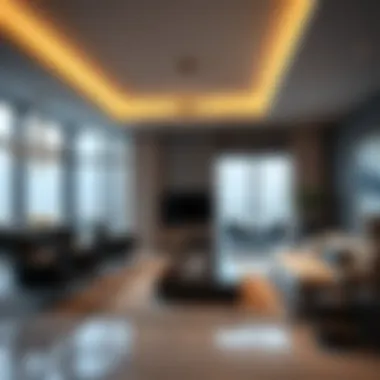
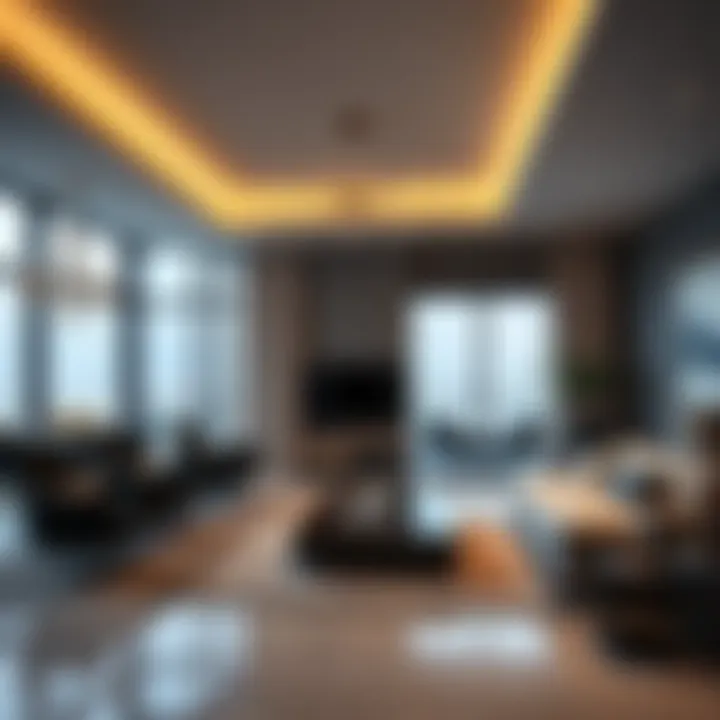
Intro
Dubai's real estate has become a tapestry woven with luxury, culture, and design. At the center of this creative surge are interior designers. They are not just decorators; they are crucial players in shaping the unique character of both residential and commercial spaces. With the city boasting a diverse and eclectic population, the role of these designers cannot be overstated. They face a landscape that is continuously changing, balancing traditional tastes and modern aesthetics. This article aims to illuminate how interior designers in Dubai have carved their niche within the real estate market, examining their challenges, inspirations, and the current trends that define the industry.
Market Insights
Current Trends in Dubai Real Estate
In recent years, the real estate scene in Dubai has experienced a renaissance, influenced sharply by market demands. One significant trend is the shift towards sustainability. Developers and designers alike are increasingly integrating eco-friendly materials and energy-efficient technologies in their projects. This movement resonates well with the global push for green living, making Dubai a leader in sustainable design in the Middle East.
Additionally, there’s a noticeable penchant for minimalistic designs, where simplicity reigns over extravagance. This aesthetic appeals to a more urban lifestyle, reflecting the values of a younger, more dynamic population. Beyond aesthetics, smart home technology is making waves across both residential and commercial spaces, highlighting an era where convenience and innovation take precedence.
Price Fluctuations and Forecasts
When it comes to pricing, the dynamics can be a bit rocky. Property values in Dubai see fluctuations influenced by various factors such as global economic climate, oil prices, and foreign investments. Historically, prices peaked around 2014 before entering a downward trajectory. However, recent data suggests a gradual recovery as the market adjusts.
"As per the latest reports from property analysts, it’s evident that attractive pricing and vibrant design elements are vital to reviving buyer interest in Dubai's real estate."
Analysts forecast a steady climb in prices over the next few years, driven largely by the influx of expatriates and the government’s continued investment in infrastructure.
Property Buying Guides
Steps to Buy Property in Dubai
For investors looking to navigate the Dubai real estate market, understanding the process of purchasing property is crucial. Here’s a simplified roadmap:
- Determine Your Budget: Setting a realistic budget helps narrow down options.
- Research Locations: Investigate neighborhoods that meet your lifestyle and investment goals. Popular districts include Dubai Marina, Downtown Dubai, and Jumeirah.
- Engage with a Trusted Realtor: Building relationships with realtors who have experience in Dubai is essential; they can guide you through the complexities.
- Review Legal Documentation: Before making any commitments, ensure you thoroughly read contracts and assess the legalities.
- Secure Financing: If you're planning to finance your purchase, comparing mortgage rates and terms is a must.
- Finalize Your Purchase: Once everything aligns, make your offer and fulfill all legal requirements for ownership transfer.
Legal Considerations for Buyers
Navigating the legal landscape of property purchase in Dubai requires careful attention. Foreigners can own property outright in designated freehold areas, allowing for direct investment. It’s crucial to engage local legal help to understand:
- Title Deeds: Ensure clear and legitimate title to avoid future disputes.
- Fees and Taxes: Be aware of the property registration fee, which is typically around 4% of the purchase price.
- Community Regulations: Often, communities have their own rules regarding property usage and management, which need to be adhered to strictly.
For more detailed information on property ownership, you can visit Dubai Land Department.
With the role of interior designers intertwined deeply in this sector, understanding the nuances of market trends and buying regulations helps potential investors make informed decisions. The ever-evolving nature of design and function in Dubai's real estate means collaboration with knowledgeable designers can elevate both personal living spaces and commercial endeavors.
The Essence of Interior Design in Dubai
Interior design is more than just aesthetics. In a city like Dubai, where luxury meets cultural diversity, it holds a crucial position in shaping spaces that resonate with the inhabitants' identities. Designers here play a vital role, transforming structures into places of comfort, elegance, and functionality. The essence lies in creating environments that reflect not only personal taste but also the profound cultural and social influences that characterize Dubai.
Cultural Influences on Design
Dubai's interior design is a melting pot of various influences stemming from its rich history and multicultural populace. The blend of traditional Middle Eastern motifs with contemporary styles has resulted in spaces that tell a story. For instance, many designs incorporate intricate geometric patterns typical of Islamic art alongside sleek modern lines. This fusion creates a sense of continuity between the past and present, appealing to both residents and visitors. Moreover, elements like ornate calligraphy and rich textiles not only enhance aesthetic appeal but also instill a sense of place and cultural pride in the occupants.
Architectural Marvels and Design Integration
The skyline of Dubai is dotted with architectural wonders, from the Burj Khalifa to the Palm Jumeirah. These bold structures redefine modern living and offer a unique canvas for interior designers. Here, the integration of indoor and outdoor spaces is paramount. Designers are tasked with ensuring that the interior aesthetics harmonize with the grandeur of the exterior architecture. High ceilings and vast windows showcasing breathtaking views are common features. Such considerations not only enhance the visual appeal but also contribute to the emotional experience of living and working in these spaces.
Trends Shaping Interior Design
Contemporary Aesthetics
Contemporary aesthetics dominate the Dubai interior design scene. Its clean lines, open spaces, and minimalistic approach cater to the tastes of many modern homeowners and businesses. One of the key characteristics of contemporary aesthetics is its ability to adapt. This style can effortlessly accommodate personal touches, making spaces feel unique while also maintaining an overall sleek appearance. The simplicity of form often creates a tranquil ambiance, appealing to residents looking for comfort amidst the city’s energetic environment. However, there can be a downside; some might find the minimalist approach too stark, lacking warmth and character.
Sustainable Materials
Sustainable materials are becoming increasingly popular in Dubai's interior design markets. With a growing awareness about environmental impact, designers are integrating eco-friendly options into their projects. Materials like reclaimed wood, bamboo, and recycled metals are drawing attention for their aesthetic qualities and sustainability aspects. This increasing focus on sustainability not only caters to a conscientious clientele but also promotes long-term cost savings through energy-efficient designs. While the initial costs may be higher, the long-term benefits—both financial and environmental—make sustainable choices wise investments for property owners.
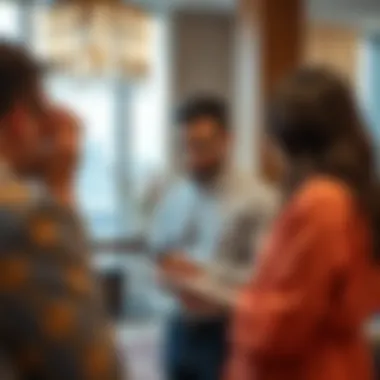

Smart Homes
The rise of smart home technology is another significant trend shaping Dubai’s interior design landscape. From intelligent lighting systems to automated climate control, integrating technology into design has become increasingly essential. Smart homes provide convenience, security, and energy efficiency, making them a desirable choice for tech-savvy residents. This integration, however, can pose challenges in terms of maintaining aesthetic appeal while incorporating hardware and software solutions. Balancing technology with design is an ongoing task for designers to ensure that homes remain inviting while embracing modern innovation.
"Interior design in Dubai is not just about what meets the eye; it’s about creating spaces that embody a lifestyle, reflect culture, and promote sustainability."
The essence of interior design in Dubai encompasses a myriad of influences, trends, and challenges, shaping not only the physical spaces but also the lives of the people who inhabit them.
The Professional Landscape of Interior Designers in Dubai
The role of interior designers in Dubai's rapidly evolving real estate market cannot be overstated. They are not just artists creating visually appealing spaces; they are strategic partners in the development and enhancement of residential and commercial properties. In a city where luxury and opulence are celebrated, interior designers shape environments that resonate with the vibrant lifestyle and aspirations of its residents and visitors. Their input influences property values, attracts clientele, and directly contributes to the economic fabric of the region.
Educational Pathways and Qualifications
Entering the world of interior design in Dubai requires a blend of creativity and technical skill. Most designers begin their journey with formal education. Universities in Dubai, such as the American University in Dubai and the British University in Dubai, offer specialized degrees in interior design. These programs cover essential topics ranging from the history of design and space planning to modern materials and environmental psychology.
Certification systems, like the National Council for Interior Design Qualification (NCIDQ), also play a significant role. This certification is highly regarded and demonstrates a designer's knowledge and competency in the field. Furthermore, many professionals pursue memberships in organizations such as the International Interior Design Association (IIDA) and the American Society of Interior Designers (ASID). These memberships not only lend credibility but also provide networking opportunities and continuous education.
Notable Interior Design Firms
Established Leaders
A look at established interior design firms in Dubai reveals significant influences on the city's design landscape. Companies like DWP and Woods Bagot have years of experience under their belts, transforming commercial spaces into inviting environments.
One key characteristic of these leaders is their vast portfolio that stretches across industries—from luxury hospitality to high-end residential projects. Their rich experience provides clients with a sense of security and assurance of quality work.
However, their established reputation can lead to higher costs and sometimes less flexibility for personalized designs. Clients often find that these firms typically follow distinct styles which, while impressive, may not cater to those looking for more customized or unique solutions.
Emerging Talent
On the flip side, emerging designers bring fresh perspectives and innovative ideas to the table. Designers like Paul Bishop and Aida Al Gameel represent a new wave of talent that is changing the design dynamics in Dubai. They often emphasize sustainability and local craftsmanship, which resonates well with a rising eco-conscious audience.
The hallmark of these emerging talents is their willingness to push boundaries and explore new materials and technologies to create spaces that are not only functional but also inspirational. However, their limited experience means clients may take on additional risks when hiring these newer firms. Still, the potential for creativity and innovation can lead to standout projects that break traditional design molds.
Freelance versus Agency Work
When considering a career in interior design in Dubai, both freelance work and agency employment have their pros and cons.
Freelancers often enjoy the freedom of selecting their projects, which allows for greater creativity and flexibility. This can be especially appealing for those wanting to carve a unique niche in the market or work on diverse projects without the constraints typically found in a larger agency context. However, freelancers may face challenges such as inconsistent income and a lack of administrative support.
Agencies, on the other hand, offer stability and a plethora of resources. Working within an agency often grants designers access to a broader range of projects and clients. Yet, this structure may come with rigid hierarchies and less individual creative control.
Ultimately, the choice between freelancing and agency work depends on a designer's career goals and personal work preferences.
Navigating Client Relationships
Navigating the intricate web of client relationships is an indispensable aspect of an interior designer's role in Dubai's bustling real estate market. Given the city's melting pot of cultures and various backgrounds, understanding what clients want is crucial. It's not just about creating a visually appealing space; it’s about crafting environments that resonate with the client's personality and lifestyle.
Understanding Client Needs
Designers must hone in on their clients' individual desires, preferences, and lifestyles to ensure that the final outcome reflects their vision. It's essential to initiate conversations that delve deeper beyond mere aesthetics.
- Listening Skills: Designers should be adept at not just hearing words but grasping the underlying emotions and intentions behind them. This attentiveness can yield insights that guide the design process effectively.
- Cultural Awareness: Each client in Dubai may bring unique cultural preferences. The designer's ability to appreciate and integrate these can lead to a more harmonious design.
- Lifestyle Insights: Understanding how clients live, work, and entertain aids in functionality. For instance, a family-oriented client will have different needs compared to a single businessman.
The Design Consultation Process
A well-structured design consultation sets the stage for successful project execution. This phase is where ideas germinate and grow into a viable project plan.
- Initial Meetings: These are crucial for establishing rapport. Creating a comfortable open space where clients feel free to share their thoughts is imperative. It’s all about building trust from the get-go.
- Questionnaires and Briefs: Many designers opt to use thorough questionnaires to guide the discussion. This document can help capture essential details like preferred styles, color palettes, and functional needs.
- Visual Inspirations: Designers often provide mood boards or portfolios during meetings. This can help clients articulate their vision, making it easier to pin down the direction for the project.
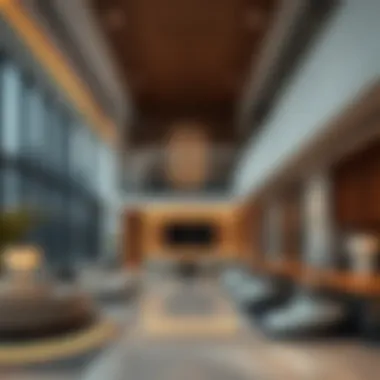
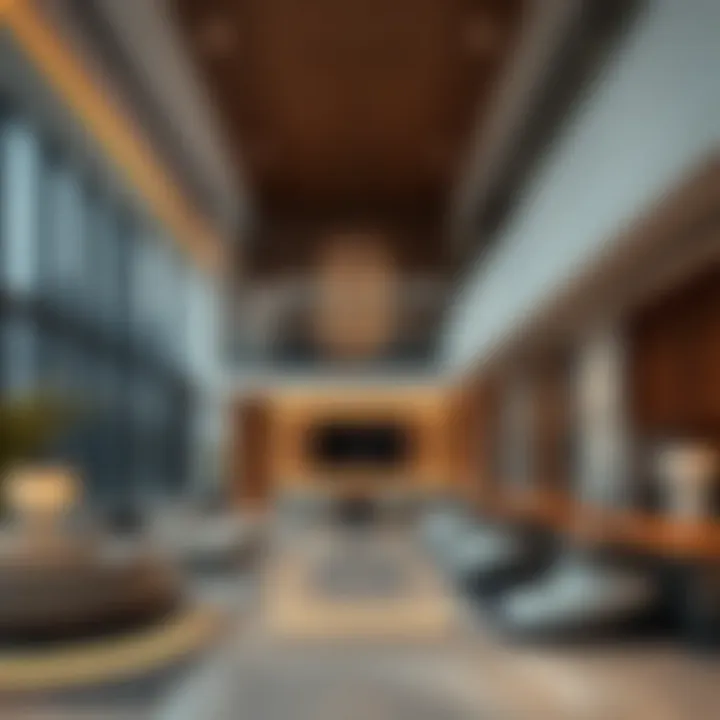
Once all this information is gathered, it’s crucial to summarize the findings back to the client, ensuring that there's no misunderstanding of their vision.
Handling Feedback and Revisions
Every design project will inevitably encounter revisions. The key lies in how feedback is managed to keep the relationship intact and the project flourishing.
- Active Listening to Feedback: When it comes to receiving client feedback, it’s vital to listen actively. Approach criticism not as a personal affront but as a pathway to a better outcome.
- Flexibility: Designers must remain adaptable. Clients’ tastes can evolve throughout the project. Being willing to shift gears can be beneficial.
- Communicating Revisions: Providing clear explanations when changes are necessary can enhance client trust. For example, if a suggested color doesn’t work well with a particular material, articulating this thoughtfully is important.
Ultimately, success in client relationships is built on open communication, respect, and an inherent understanding of the client's journey through the design process. As complex as these relationships may seem, they form the backbone of an effective design solution that satisfies both the client and the designer.
"A good interior designer is not just a stylist; they are a problem solver, balancing aesthetics and practicality while ensuring the client feels heard and valued."
By investing in these relationships with a genuine approach, interior designers can navigate the often tumultuous waters of the Dubai real estate landscape while helping their clients build spaces that truly feel like home.
Additionally, those keen on enhancing their understanding of client relationships can refer to resources such as Encyclopedia Britannica for insights into effective interpersonal communications.
Impact of Technological Advancements
The introduction of technological advances has kicked away the dust and brought a fresh breeze to Dubai's interior design scene. It's not just about aesthetics anymore; technology plays a key role in shaping spaces to make them function, appealing, and, most importantly, efficient. Interior designers in Dubai now utilize an array of innovative tools and techniques to create environments that resonate with modern living while also keeping in step with clients’ needs and wants.
Virtual Reality in Design
Virtual Reality (VR) represents a major leap forward in how designers can showcase their concepts. Rather than relying solely on flat drawings or 3D models, designers can now immerse clients in fully interactive environments. With VR, a client can virtually walk through their new space before any work even begins. This tool has proven to be invaluable during design presentations, enabling clients to visualize the end product more accurately.
Furthermore, by using VR, designers can experiment without the risks associated with real-world changes. Want to swap out the wall color from teal to a vibrant mustard? No problem! The immediacy of VR means adjustments can be made on the fly, saving both time and resources.
3D Modeling and Visualization
3D modeling has revolutionized how interior designers work. By developing detailed models that mirror the final outcome, designers can communicate ideas with clarity. Not only does this provide a more engaging way for clients to see designs, but it also enhances collaboration among stakeholders like architects and engineers.
With tools like SketchUp or Blender, interior designers can play with shapes, colors, and textures in a virtual space. From sleek apartments to massive commercial projects, 3D modeling allows clients to grasp how elements fit together, making for a smoother decision-making process. The accurate simulations also help in identifying potential issues early on, reducing the likelihood of costly changes late in the project.
The Role of Artificial Intelligence
Artificial Intelligence (AI) might sound high-tech, but it’s making waves in a practical way in interior design too. From automating routine tasks to providing deep insights on design trends, AI serves as an additional layer of support for designers.
Tools equipped with AI can analyze thousands of design preferences and trends, giving designers a wealth of information that shapes their recommendations. Systems such as DesignAI work with the preferences and feedback of a designer's previous clients, allowing for tailored suggestions that align more closely with individual tastes and styles.
It doesn’t stop there; AI can also assist in optimizing plans and layouts based on functionality. For instance, it can suggest the most effective arrangement of furniture based on user behavior from past projects. This ability to streamline processes enhances productivity, helping designers meet tight deadlines without sacrificing quality.
The intersection of technology and interior design is not just a trend; it is a shift towards precision and efficiency, paving the way for smarter, more sustainable living.
By incorporating these technological advancements, interior designers in Dubai are uniquely equipped to not just meet, but exceed the expectations of their clients. This fusion of traditional skills with modern tools is where the future of interior design lies.
Challenges Faced by Interior Designers
The role of interior designers in Dubai’s bustling real estate scene comes with its share of hurdles. As the market evolves, the challenges grow increasingly complex. Understanding these obstacles is crucial for both designers and their clients, providing insight into the realities of transforming spaces while addressing expectations and resource limitations. This section clarifies the plausibility of aspirational designs and adresses the nuances of working within Dubai's context.
Client Expectations versus Reality
When homeowners or business clients seek an interior designer in Dubai, they often show up with sparkling visions of luxurious spaces—think golden accents, intricate carvings, and floor-to-ceiling windows with breathtaking views. The design often seems as much about status as it is about functionality. However, these expectations can clash with reality.
Balancing client dreams with practical limitations is a tightrope act. For instance, a client might want a sleek, modern office setup but does not understand the physical limitations of their space. Interior designers must skillfully guide clients towards feasible solutions while ensuring that the final product still resonates with the client’s initial vision. This requires deft negotiation and an ability to manage emotions, tempering enthusiasm with grounded advice.
"Bridging the gap between fantasy and practicality is where the designer truly earns their keep."
Regulatory and Compliance Issues
Dubai's regulatory environment presents a daunting landscape for interior designers. Adhering to local laws, building codes, and community guidelines is not just a box to check; it is a matter of professional integrity and safety. For example, every project must comply with the Dubai Municipality’s regulations concerning health and safety, environmental standards, and building height regulations. Additionally, navigating the red tape for permits can be a time-consuming ordeal, further complicating timelines and client relationships.
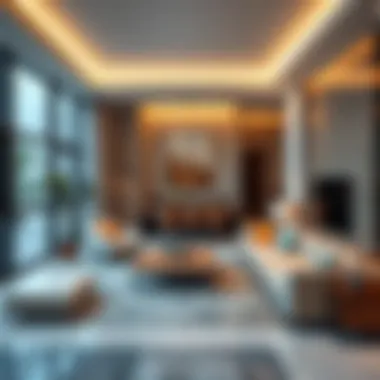
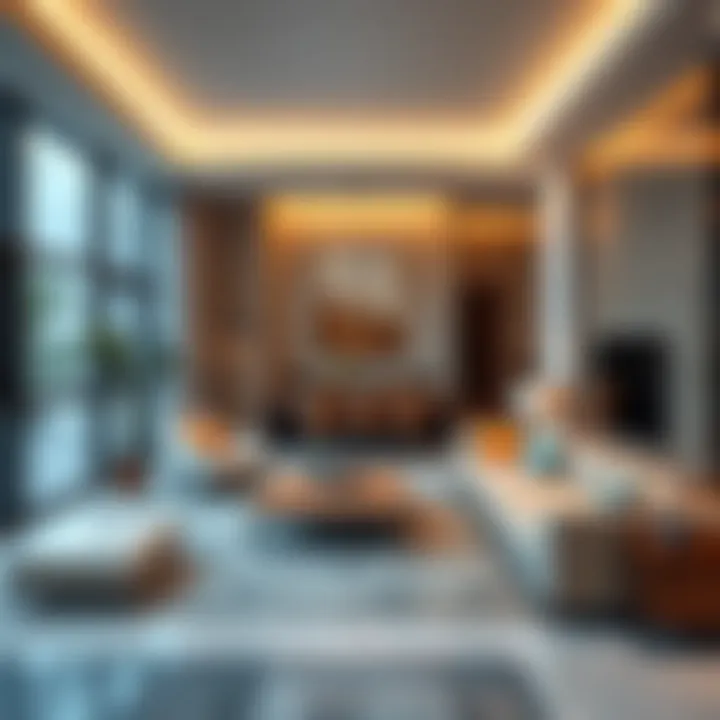
Not to be overlooked is the necessity of aligning designs with the cultural sensibilities inherent to Dubai. Designers are tasked with creating spaces that are not only aesthetically pleasing but also culturally appropriate. Failing to consider these elements can result in costly revisions and a dissatisfied client base.
Managing Budgets and Resources
Budget management can often make or break a project. With an ever-fluctuating market, securing high-quality materials at competitive prices gets tricky. Interior designers frequently must wear multiple hats—project manager, negotiator, and even financier—to keep projects within budget while maintaining quality.
The challenge lies in transparency. Clients might underestimate costs or overlook hidden expenditures, leading to friction as projects move forward. A successful designer needs to communicate budgetary expectations upfront, ensuring all parties have a realistic outlook on what can be achieved. It is a balancing act that requires tact and savvy financial planning.
Case Studies of Successful Projects
Understanding the real-world impact of interior design requires exploring case studies that reveal the nuances of successful projects in Dubai. These examples not only highlight the creative process but also the intricate relationship between design and real estate. The transformation of spaces can profoundly influence property value, tenant satisfaction, and overall functionality. Whether it’s a residential home reimagined or a cutting-edge commercial space, such case studies offer valuable insights into both challenges and triumphs.
Residential Transformations
When it comes to residential transformations, the journey typically begins with a thorough understanding of the homeowner's needs and lifestyle. Consider the example of a spacious villa in the community of Arabian Ranches. The owners sought to meld modern aesthetics with the traditional warmth of Middle Eastern culture. This was achieved by combining contemporary furnishings with handcrafted local artifacts, effectively creating a harmonious balance that resonated with their identity.
- Design Considerations: The interior designer had to consider slopes, lines of sight, and light angles that can dramatically change perceptions of space. Natural light played a significant role, with large windows framed by elegant drapery that softened the sharp edges of modern decor.
- Outcome: The final result was a welcoming environment that not only increased the home's appeal but also its market value, becoming a desirable listing in a highly competitive area.
Innovative Commercial Spaces
In commercial design, the approach is often different, focused more on functionality and business identity than personal taste. A prime instance is the recent renovation of a hotel lobby in Downtown Dubai. The goal was to create a space that reflected Dubai's luxurious lifestyle while remaining functional for high traffic.
- Design Elements: Key features included a bold color palette that incorporates gold and rich blues, echoing the opulence of the city, and modular seating arrangements that could adapt to various guest needs. The design also embraced technology, featuring smart-hubs for guests to access information easily.
- Business Impact: Post-renovation, the hotel experienced a 25% increase in customer satisfaction, evidenced by positive reviews focusing specifically on the ambiance and ease of navigation. This highlights how innovative design in commercial spaces can contribute directly to a business's bottom line.
Luxury Villas and Their Unique Design Challenges
The design of luxury villas in Dubai poses its own set of challenges. For instance, a designer tasked with working on a spectacular villa in Palm Jumeirah faced the unique challenge of incorporating opulent materials while maintaining a sense of comfort and livability.
- Complexity of Design: The challenge was not just aesthetic; it was about integrating high-end technologies while ensuring they didn't overpower the living experience. Crafting a space that speaks to luxury yet allows for cozy family interactions was paramount.
- Unique Features: Special attention was paid to outdoor spaces as well. The villa boasted multiple terraces and infinity pools that seamlessly blended indoor and outdoor living. Designers had to ensure that each space remained functional and visually cohesive.
"A designer's job is not only to create beautiful spaces but to tell a story that resonates with the people living in them."
Through these varied examples—whether a family villa, a dynamic commercial space, or a luxury retreat—case studies of successful projects in Dubai tell the story of interior design's pivotal role in shaping experiences and enhancing the value of real estate. They demonstrate how thoughtful design can bridge the gap between personal expression and commercial viability, which is vital in the dynamic landscape of Dubai's property market.
The Future of Interior Design in Dubai
With Dubai being a melting pot of cultures and a beacon of modernity, the future of interior design in this city is poised for significant transformation. As urban living continues to evolve, interior designers find themselves at the forefront of adapting spaces that not only reflect current trends but also anticipate future needs. This section highlights the pressing elements that will shape Dubai's interior design landscape in the coming years, an essential focus for investors, homebuyers, realtors, expatriates, and developers alike.
Emerging Trends to Watch
One cannot overlook the dynamic shifts that are taking place within the realm of interior design. Emerging trends are sprouting up quicker than weeds in a garden:
- Biophile Design: The concept of integrating natural elements into interiors is gaining traction. It's not just about adding a few plants; it's about creating spaces that echo nature with organic shapes, natural lighting, and earthy colors.
- Multifunctional Furniture: As living spaces shrink, designers are crafting furniture that serves multiple purposes. The compactness of urban living requires creativity that can deliver both style and functionality.
- Remote Work Friendly Designs: The rise of hybrid work environments has pushed designers to rethink home setups, prioritizing cozy and productive workspaces that blend with overall home aesthetics.
These trends reflect a broader understanding of how design can solve practical issues while also enhancing the quality of life.
Sustainability and Eco-conscious Design
In an era where environmental concerns are ever-present, sustainable design is no longer just a buzzword—it's a necessity. Designers in Dubai are leading the charge:
- Use of Reclaimed Materials: More designers are opting to use reclaimed wood, recycled metals, and other salvaged elements, pairing sustainability with style.
- Energy-efficient Solutions: Energy-efficient lighting and smart home technologies foster a lower carbon footprint while maintaining luxury and comfort within homes.
- Water Conservation Features: Incorporating water-saving fixtures and drought-resistant landscaping not only aligns with Dubai’s climate but also resonates with eco-conscious residents.
This shift towards sustainability is as much about ethical responsibility as it is about meeting market demand.
Integration of Cultural Elements
Dubai’s rich cultural tapestry offers a wealth of inspiration that interior designers are beginning to embrace in new ways:
- Local Artistry: Incorporating works from local artisans not only supports the cultural landscape but also brings uniqueness to each project. Authentic pieces can resonate with residents and give a sense of belonging.
- Cultural Symbolism: Designers are increasingly using patterns and motifs that reflect local heritage, which adds depth and meaning to interiors.
- Global Influences: As a global city, Dubai attracts influences from around the world. Designers must balance these diverse styles, ensuring that spaces feel cohesive while also honoring their cultural roots.
The future, therefore, is not just about designing visually appealing spaces but rather creating narratives that connect people to their environment.
"Design isn't just about how things look; it's about how they make you feel in the context of your unique cultural narrative."
These facets of future interior design are vital for understanding the larger picture of what residents and investors will demand moving forward in Dubai’s vibrant real estate landscape.















